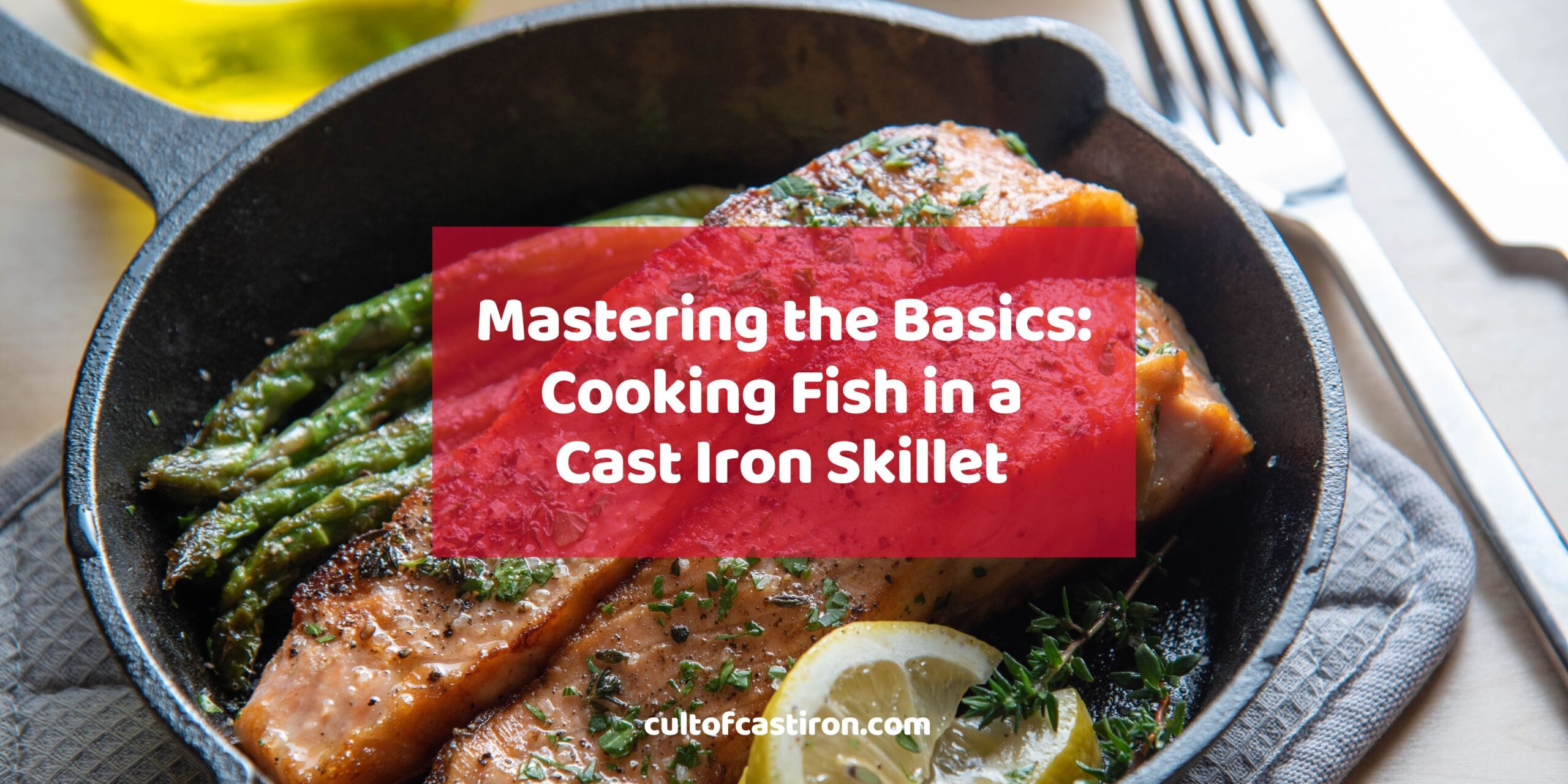Cooking fish can be intimidating for even the most seasoned home cooks. Whether it’s the fear of the delicate fish sticking to the pan or crumbling into unsightly flakes, there’s a lot that can go wrong,. But what if I told you that mastering the art of cooking fish doesn’t have to be a daunting task? The key lies in the cooking surface you choose, and a cast iron skillet could be your game-changer.
While cast iron skillets can be as finicky as aluminum and stainless steel pans when it comes to cooking fish, its seasoning provides a high level of non-stickiness, which means that your delicate fish fillets can be released from the pan without being mangled. However, this needs a few minutes of prep beforehand to pull off cleanly.
In this comprehensive guide, we’ll dive into the dos and don’ts of cooking fish in cast iron, starting with how to prevent that dreaded stickiness. So, let’s reel in some culinary wisdom!
How to Prevent Fish from Sticking to Cast Iron Skillet
Let’s explore some tried-and-true methods to ensure your fish doesn’t stick to your beloved cast iron.
Make Sure to Fully Thaw the Fish Before Cooking
Frozen fish has a tendency to stick more than its thawed counterpart. If you’re cooking straight from the freezer, make sure to fully thaw the fish in the refrigerator before you even think about placing it on the skillet. Putting an extremely cold cut of fish on a hot skillet will produce a lot of steam. This steam can disrupt the formation of a good crust. Not only does this leave you with a soggier texture, but it will lead to the fish sticking to your pan.
Thawing ensures that the fish cooks evenly and reduces the risk of it sticking to your skillet. Moreover, it quickens the cooking time of fish, thus minimizing the chances of it drying out or of uneven cooking.
Dry Fish with Paper Towels Before Cooking
Moisture is the enemy when it comes to preventing sticking. Use paper towels to pat the fish dry, removing excess moisture from the surface. This step is crucial because a dry surface forms a better crust, preventing the fish from sticking to the cast iron.
Taking off as much moisture as you can will also help reduce the instances of hot oil from splattering from your pan. It’s also great for building flavor, too! A dry surface allows seasonings and coatings to adhere better, ensuring that your fish is flavorful all the way through.
Proper Pre-heating is Key
At the right temperature, the oil reaches an optimal viscosity that allows for better interaction with the food, reducing the chances of sticking. That is why a pre-heated pan initiates the Maillard reaction quicker, giving you that desirable browned and crispy texture.
Cast iron pans are excellent at retaining heat, but they also take longer to preheat. Use a medium heat setting and give your skillet ample time to heat evenly across the surface. You’ll know it’s ready when a drop of water sizzles and evaporates quickly. For those who want to go the extra mile for even heat, rotating the skillet every few minutes during the pre-heating process can help achieve a uniformly heated cooking surface.
Use a Sufficient Amount of Oil
Don’t skimp on the oil—make sure to coat the bottom of the pan adequately. While cast iron is naturally non-stick when seasoned well, a good amount of oil creates an additional layer that acts as a barrier between the fish and the pan. The oil needs to be hot enough to fry the fish effectively but not so hot that it smokes and breaks down, which can impart a burnt flavor. This can also lead the fish to burn and stick to your pan along with the polymerizing oil in your extremely hot pan.
Using a cooking thermometer can help you monitor the oil’s temperature. Alternatively, you can flick a single drop of water into the oil – if it sizzles gently, then it is good to go. However, if it sizzle too vigorously and with wisps of smoke rising, then the oil is too hot.
Always Start Cooking Skin-side Down
If your fish fillet comes with skin, always start by cooking it skin-side down. The skin contains fats that not only add flavor but also help in preventing the fish from sticking. This method helps to crisp up the skin, adding an extra layer of texture and flavor to the dish.
Moreover, apart from being a generally-accepted culinary technique, I find that frying skin-side down first prevents my fish from devolving into a flaky mess once I flip it.
Wait Until the Fish Releases Itself from the Pan
Resist the urge to move the fish too early as this can cause the skin to rip off. If it’s sticking, that usually means it’s not ready to be flipped. As fish cooks, its proteins undergo changes that eventually allow it to naturally unstick from the cooking surface. Attempting to move it before this happens can lead to tearing. Give it time; it will release itself naturally from the pan when it’s ready. To test if it is ready, gently nudge the fish with a spatula before attempting to flip it. If it moves freely, then its time to flip the fish.
How to Flip Fish Without it Breaking Apart

Now it’s time for the crucial and nerve-wracking part of cooking fish: flipping it to the other side! Master the art of the perfect flip to ensure your fish remains intact and beautifully cooked with these tips.
1. Use the Right Tools
A thin, flexible spatula is ideal for flipping fish. It allows you to slide under the fish delicately, reducing the risk of tearing. Slide the spatula under the fish, lift it slightly off the skillet, and then quickly but gently turn it over. Avoid forceful or hasty movements that can break the fish.
It will be better to use a fish spatula versus a regular one, as the latter has a longer, slimmer, and more flexible blade compared to a regular spatula. It also has a slightly beveled edge that allows it to slide under the fish easily, providing better support for the delicate flesh.
2. Tilt the Pan
Forceful movements done with your spatula may cause unnecessary damage to the fish. If you need more help on guiding the fish onto your spatula, better let gravity do the work!
Slightly tilting the skillet can help guide the fish onto the spatula, making it easier to execute the flip without breakage. You just have to be extra sure that the skin has already released from the pan. To check this in a gentle manner, move the pan in a circular motion – if the fish moves freely with the pan, then it is ready.
3. Flip with Confidence
The flip itself should be executed quickly to minimize the risk of the fish breaking apart. Once that the spatula is firmly under the fish, you should execute a quick up-and-over motion with your hands guiding the top part of the fish. Don’t flip the fish too high as it increases the risk of it breaking apart.
How to Get Fish Smell Out of Cast Iron Skillet
While cooking fish in a cast iron skillet can yield delectable results, it can also leave behind an unpleasant, lingering aroma. In this section, we’ll explore methods to effectively remove that fishy smell from your skillet
1. Clean the skillet immediately after cooking with fish
After cooking, you should clean your cast iron pan immediately to easily remove any leftover bits of fish or cooking oil from the skillet. Run hot water over the skillet to loosen any stuck particles. Alternatively, you can fill the skillet with water and bring it to a boil for about 5-10 minutes. This can help lift the smell from the skillet’s pores. From there, use a sponge or scrubber to remove as much debris as you can.
2. Use mild dish soap
Contrary to popular belief, modern, mild dish soap does not pose any harm to your skillet. Lathering your favorite dish soap on your skillet can mask and remove the fishy smell from your pan.
3. Rub baking soda paste all over the skillet
Baking soda can help neutralize particularly stubborn odors. Make a paste using equal parts water baking soda and apply it to the skillet. Let it sit for a few minutes before rinsing.
If the odor is particularly stubborn, an alternative is sprinkling baking soda powder over the skillet and let it sit overnight. From there, you should rinse the baking soda off the skillet, then treat the cast iron skillet with oil as usual.
Reeling It In: Final Thoughts on Fish and Cast Iron
As we reel in our discussion, it’s clear that mastering the art of cooking fish in a cast iron skillet is not just about the initial sizzle. It’s a holistic process that starts with proper preparation and extends to post-cooking care for your cast iron cookware.
Armed with these practical tips and techniques, you’re now well-equipped to turn any catch of the day into a culinary masterpiece.
To learn more about cooking with cast iron, check out Cult of Cast Iron! Scroll through our blog dedicated to all things cast iron and find helpful tips and tricks to level up your cast iron skills! Discover a whole new world of cooking and spread the Cult of Cast Iron word today!

Miguel is a cast iron enthusiast from Cavite, Philippines. He works in the digital marketing field as a content marketing strategist. On the side, he manages a small online bookstore and tends to his plants.

